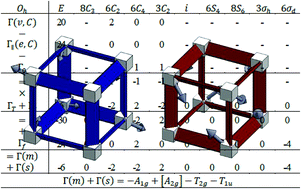Flexibility in MOFs: do scalar and group-theoretical counting rules work?†
Abstract
We investigate the ability of counting rules drafted from engineering to predict the flexibility or rigidity of bar-and-joint or body-and-joint assemblies representing metal organic frameworks. We show that while scalar counting rules are not reliable, group-theoretical approaches are able to disentangle mechanisms from states of self-stress and to predict the existence of flexible mechanisms. We give several detailed examples of such calculations, highlighting the fact that behind an abstract exterior they are in fact easy to apply and similar to the method used to obtain molecular vibrations. We also correct a slight misinterpretation of the rigidity of IRMOF-1.

- This article is part of the themed collection: Flexibility and Disorder in Metal-Organic Frameworks

 Please wait while we load your content...
Please wait while we load your content...